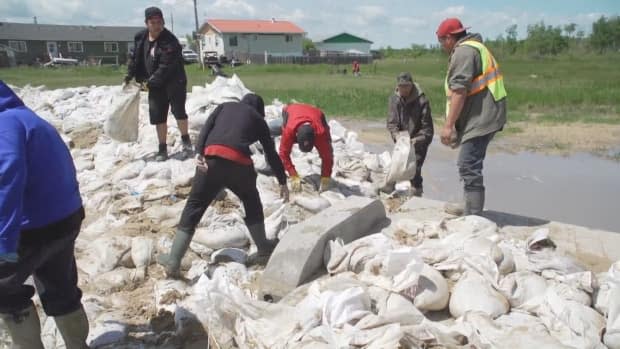Infrastructure fixes to halt floods on Peguis First Nation sorely needed, leaders say

All levels of government need to come together to help solve flood-related infrastructure issues on Manitoba's largest First Nation, community leaders said.
"There is serious work to do," William Sutherland, Peguis First Nation's director of emergency management, said in an interview Sunday as the flood-battered community north of Winnipeg was toiling to again try and shore up structures, roads and homes as water levels rise from recent rainfall.
"There is a lot of infrastructure work that needs to be done," Sutherland said.
On Thursday, Peguis reinstated a state of emergency due to high winds and rainfall.
Its latest flood fight comes as the community is still assessing how it will pick up the pieces from last month's flood.
Roughly 1,900 evacuees from Peguis still haven't returned to their homes. "It was just too risky for people to come back right now," said Sutherland.
Peguis Chief Glenn Hudson told CBC on Sunday some of those people might not be able to come back for up to two years. Hudson said crews had identified 60 homes in the community as "written off" in terms of damage from the current flooding; about 300 people who lived in them are directly affected, he added.

Now, an added concern: Sutherland said some community homes now also have roof issues contributing to the flooding.
Sutherland said the First Nation has been working on putting ring dikes and berms around homes, but a longer-term solution is needed.
He pointed to a major highway – Highway 224 – which runs through the community and is a connection to the province's south for many communities to the north of Peguis.
Sutherland said since he was young the road has been hit by flood waters more than 20 times, yet the province has not worked to build it up and protect it from happening.
The lack of attention to the issue is frustrating, Sutherland said.

Peguis — the largest First Nation in Manitoba, with 3,521 members usually living on reserve and 6,504 off-reserve members — is no stranger to flooding.
In 1907, the people of the former St. Peter's Reserve were forced onto the flood-prone delta where Peguis is today, about 160 kilometres north of Winnipeg.
Federal Northern Affairs Minister Dan Vandal previously said his office had received a copy of the long-term infrastructure plans proposed by Peguis and that he'd work co-operatively with the First Nation on long-term solutions.
The federal government has provided $2.5 million to the First Nation. But Hudson said much more needs to be done, and soon, for long-term flood mitigation measures.
Provincial officials have also promised to work with leaders in Peguis and with the federal government to improve flood protection in the community, a spokesperson for the provincial government said last month.
Hudson told CBC the community has the plans for the long-term fixes but about $300 million is needed to put them in place. Government is listening and there's dialogue, he said, but what's needed are agreements and capital.
"We need major money, major capital investment in terms of our infrastructure," said Hudson.
Hudson estimated the long-term solutions could take from three to five years to be put in place. "But we still need solutions for the short term," he said.


